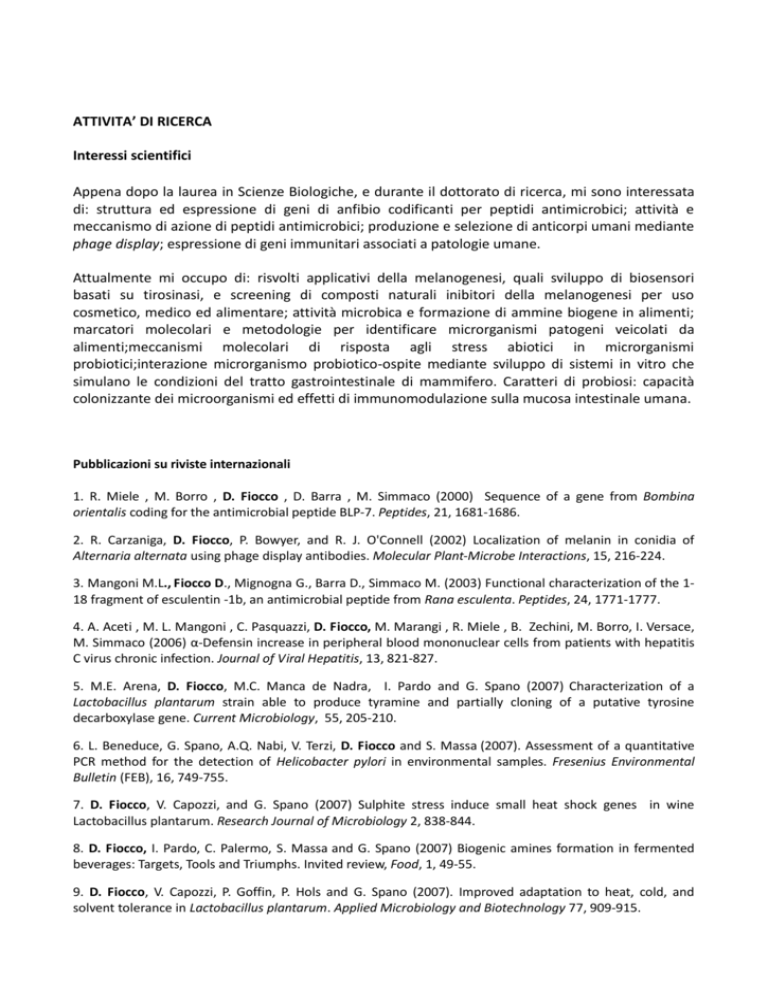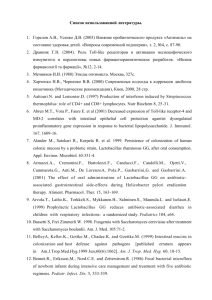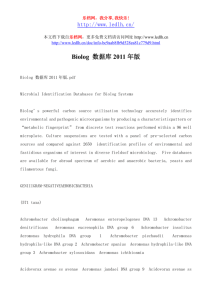ATTIVITA` DI RICERCA Interessi scientifici Appena dopo la laurea in
advertisement

ATTIVITA’ DI RICERCA Interessi scientifici Appena dopo la laurea in Scienze Biologiche, e durante il dottorato di ricerca, mi sono interessata di: struttura ed espressione di geni di anfibio codificanti per peptidi antimicrobici; attività e meccanismo di azione di peptidi antimicrobici; produzione e selezione di anticorpi umani mediante phage display; espressione di geni immunitari associati a patologie umane. Attualmente mi occupo di: risvolti applicativi della melanogenesi, quali sviluppo di biosensori basati su tirosinasi, e screening di composti naturali inibitori della melanogenesi per uso cosmetico, medico ed alimentare; attività microbica e formazione di ammine biogene in alimenti; marcatori molecolari e metodologie per identificare microrganismi patogeni veicolati da alimenti;meccanismi molecolari di risposta agli stress abiotici in microrganismi probiotici;interazione microrganismo probiotico-ospite mediante sviluppo di sistemi in vitro che simulano le condizioni del tratto gastrointestinale di mammifero. Caratteri di probiosi: capacità colonizzante dei microorganismi ed effetti di immunomodulazione sulla mucosa intestinale umana. Pubblicazioni su riviste internazionali 1. R. Miele , M. Borro , D. Fiocco , D. Barra , M. Simmaco (2000) Sequence of a gene from Bombina orientalis coding for the antimicrobial peptide BLP-7. Peptides, 21, 1681-1686. 2. R. Carzaniga, D. Fiocco, P. Bowyer, and R. J. O'Connell (2002) Localization of melanin in conidia of Alternaria alternata using phage display antibodies. Molecular Plant-Microbe Interactions, 15, 216-224. 3. Mangoni M.L., Fiocco D., Mignogna G., Barra D., Simmaco M. (2003) Functional characterization of the 118 fragment of esculentin -1b, an antimicrobial peptide from Rana esculenta. Peptides, 24, 1771-1777. 4. A. Aceti , M. L. Mangoni , C. Pasquazzi, D. Fiocco, M. Marangi , R. Miele , B. Zechini, M. Borro, I. Versace, M. Simmaco (2006) α-Defensin increase in peripheral blood mononuclear cells from patients with hepatitis C virus chronic infection. Journal of Viral Hepatitis, 13, 821-827. 5. M.E. Arena, D. Fiocco, M.C. Manca de Nadra, I. Pardo and G. Spano (2007) Characterization of a Lactobacillus plantarum strain able to produce tyramine and partially cloning of a putative tyrosine decarboxylase gene. Current Microbiology, 55, 205-210. 6. L. Beneduce, G. Spano, A.Q. Nabi, V. Terzi, D. Fiocco and S. Massa (2007). Assessment of a quantitative PCR method for the detection of Helicobacter pylori in environmental samples. Fresenius Environmental Bulletin (FEB), 16, 749-755. 7. D. Fiocco, V. Capozzi, and G. Spano (2007) Sulphite stress induce small heat shock genes in wine Lactobacillus plantarum. Research Journal of Microbiology 2, 838-844. 8. D. Fiocco, I. Pardo, C. Palermo, S. Massa and G. Spano (2007) Biogenic amines formation in fermented beverages: Targets, Tools and Triumphs. Invited review, Food, 1, 49-55. 9. D. Fiocco, V. Capozzi, P. Goffin, P. Hols and G. Spano (2007). Improved adaptation to heat, cold, and solvent tolerance in Lactobacillus plantarum. Applied Microbiology and Biotechnology 77, 909-915. 10. D. Fiocco, E. Crisetti, V. Capozzi and G. Spano (2008) Validation of an internal control to apply reverse transcription quantitative PCR to study heat, cold and ethanol stresses in Lactobacillus plantarum. World Journal of Microbiology and Biotechnology, 24:899-902. 11. D. Fiocco, M. Collins, L. Muscariello, P. Hols, M. Kleerebezem, T. Msadek, and G. Spano. (2009) The Lactobacillus plantarum ftsH gene is a novel member of the CtsR stress response regulon. Journal of Bacteriology 191:1688–1694. 12. V. Capozzi, D. Fiocco, M.L. Amodio, A. Gallone and G. Spano (2009). Bacterial Stressors in Minimally Processed Food. Int. J. Mol. Sci. 10:3076-3105. 13. V. Capozzi, D. Fiocco, S. Weidmann, G. Felis, and G. Spano. (2009) The hsp16 gene of the probiotic lactobacillus acidophilus is differently regulated by single and combined stress as revealed by reverse transcription queantitative PCR (qRT-PCR). Annals of Microbiology vol 59- special issue, p.45 (I.F. about 0,6). 14. D. Fiocco, V. Capozzi, M. Collins, A. Gallone, P. Hols, J. Guzzo, S. Weidmann, A. Rieu, T. Msadek and G. Spano (2010). Characterization of the CtsR stress response regulon in Lactobacillus plantarum. Journal of Bacteriology 192:896–900. 15.D.Fiorentino, A.Gallone, D. Fiocco, G. Palazzo, A. Mallardi (2010). Mushroom Tyrosinase in Polyelectrolyte Multilayers as an Optical Biosensor for o-diphenols. Biosensors and Bioelectronics 25:203320 37. 16. V. Capozzi, S. Weidmann, D. Fiocco, A. Rieu, P. Hols, J. Guzzo and G. Spano (2011). Inactivation of a small heat shock protein affects cell morphology and membrane fluidity in Lactobacillus plantarum WCFS1. Research Microbiology. 162:419-425. 17. D. Fiocco, D. Fiorentino, L. Frabboni, S. Benvenuti, G. Orlandini, F. Pellati, and A. Gallone. (2011) Lavender and peppermint essential oils as effective mushroom tyrosinase inhibitors: a basic study. Flavour and Fragrance Journal 26:441–446. 18. Capozzi V., Arena M. P., Crisetti E., Spano G., Fiocco D. (2011) The hsp 16 gene of the probiotic Lactobacillus acidophilus is differently regulated by salt, high temperature and acidic stresses as revealed by reverse transcription quantitative PCR (qRT-PCR) analysis. International Journal of Molecular Science 12:5390-5405. 19. P. Bove, V. Capozzi, D. Fiocco, G. Spano. (2011) Involvement of the sigma factor sigma H in the regulation of a small heat shock gene in Lactobacillus plantarum WCFS1. Annals of Microbiology 61: 973977. 20. V. Capozzi, D. Fiocco, S. Weidmann, J. Guzzo and G. Spano (2011). Increasing membrane protection in Lactobacillus plantarum cells overproducing small heat shock proteins. Annals of Microbiology. DOI 10.1007/s13213-011-0285-7 21. Bove P., Capozzi V., Garofalo C., Rieu A., Spano G., Fiocco D. (2011) Inactivation of the ftsH gene of Lactobacillus plantarum WCFS1: effects on growth, stress tolerance, cell surface properties and biofilm formation. Microbiological Research (MICRES-D-11-00162R1 doi:10.1016/j.micres.2011.07.001). Book Chapters 1. Simmaco M., Mangoni M. L., Miele R., Borro M., Fiocco D., Barra D., Ascenzi P., Ponticelli F., Visca P. (2003) Defence peptides in the amphibian immune system. In Bacterial, Plant & Animal Toxins. Editor(s) Paolo Ascenzi, Fabio Polticelli and Paolo Visca. S.G. Pandalaid., Research Signpost eds, Trivandrum (India), pp. 155-167. 2. M.L. Mangoni, D. Fiocco, D. Barra, and M. Simmaco (2006) Bombinins. In Handbook of Biologically Active Peptides, Editor: Abba J. Kastin, Academic Press, Elsevier, pp. 333-339. 3. L. Beneduce, D. Fiocco, and Giuseppe Spano (2007) Development of molecular tools for the detection of food- and water-borne pathogenic bacteria. In Communicating Current Research and Educational Topics and Trends in Applied Microbiology, Microbiology book series, Editor: A. Mendez Vilàs, pp569-576. 4. P. Russo, G. Spano, M.P. Arena, V. Capozzi, D. Fiocco, F. Grieco and L. Beneduce. (2010) Are consumers aware of the risks related to Biogenic Amines in food? In Current Research, Technology and Education Topics in Applied Microbiology and Microbial Biotechnology, pp 1087-1095, vol.2, Formatex Research Center, Editor: A. Mendez Vilas. 5. V. Capozzi, D. Fiocco and G. Spano (2011) Cold stress response in Lactic Acid Bacteria. In Stress response of Lactic Acid Bacteria, eds K. Papadimitriou and E. Tsakalidou, Food Microbiology and Food Safety, chapter 5, pp 91-110, Springer Science-Business Media, LLC 2011, New York. 6. Bove P., Fiocco D., Gallone A., Perrotta C., Grieco F., Spano G. and V. Capozzi (2011) Abiotic Stress Responses in Lactic Acid Bacteria in Stress Responses in Foodborne Microorganisms, Nova Science Publishers, Inc. Editor H. Wong (in press).

